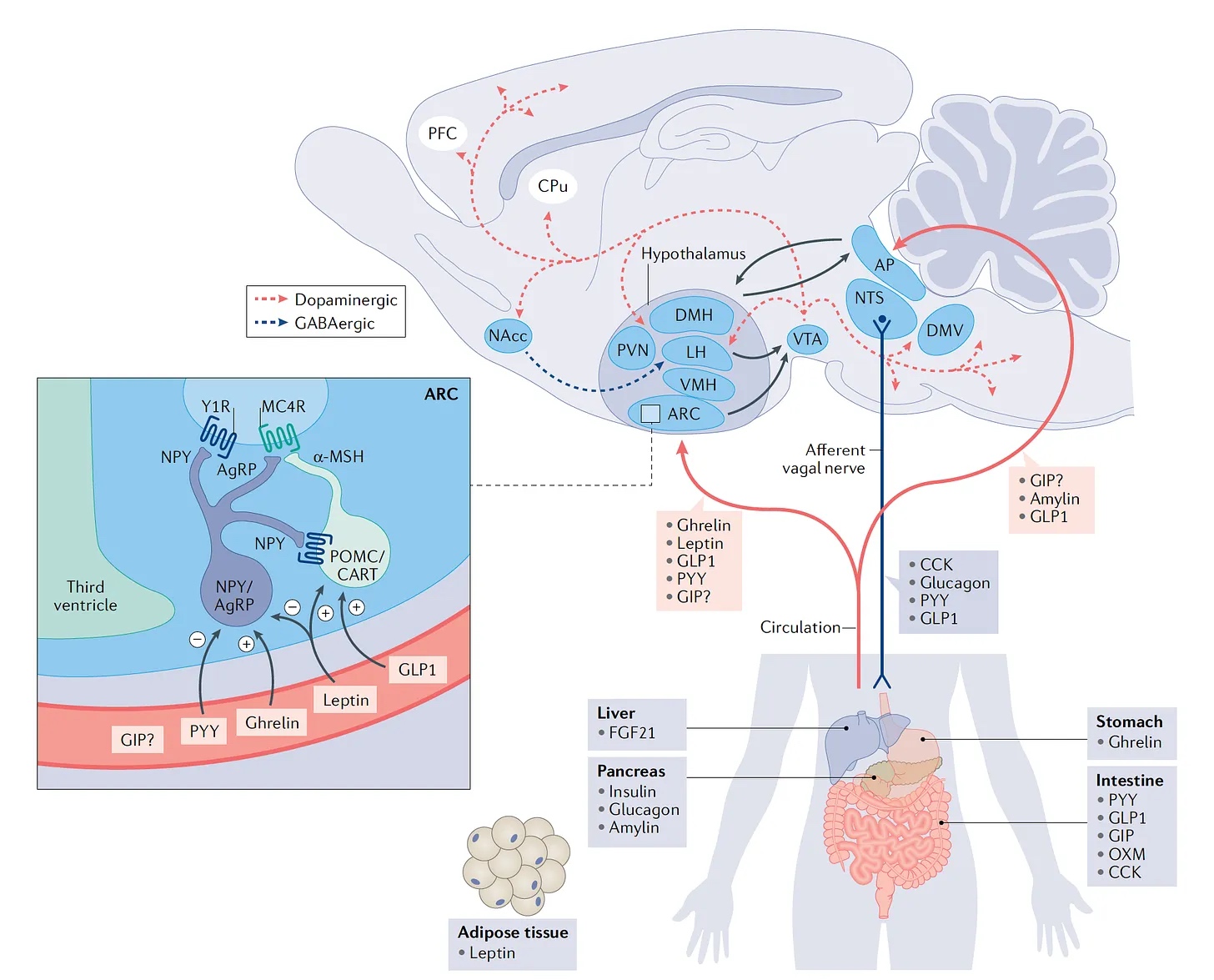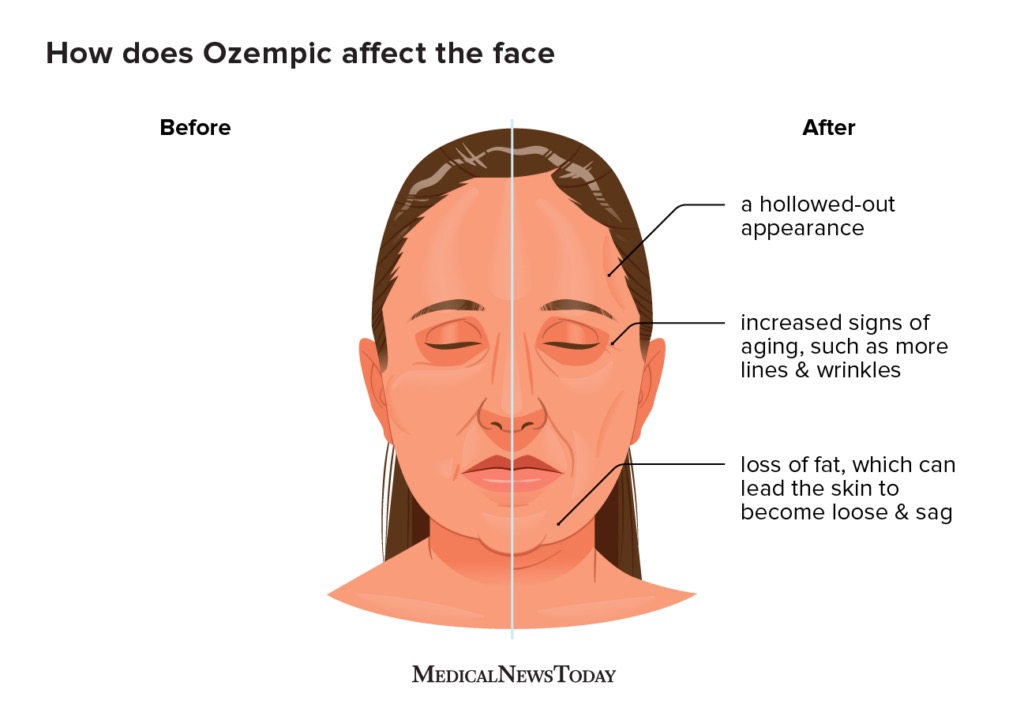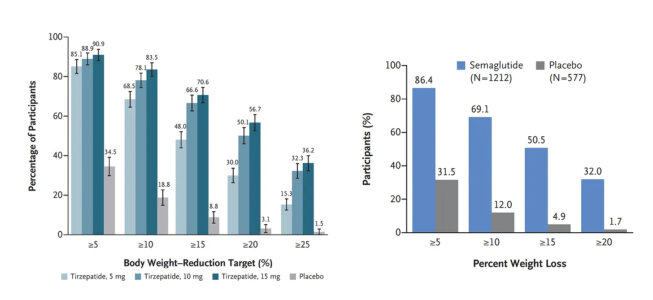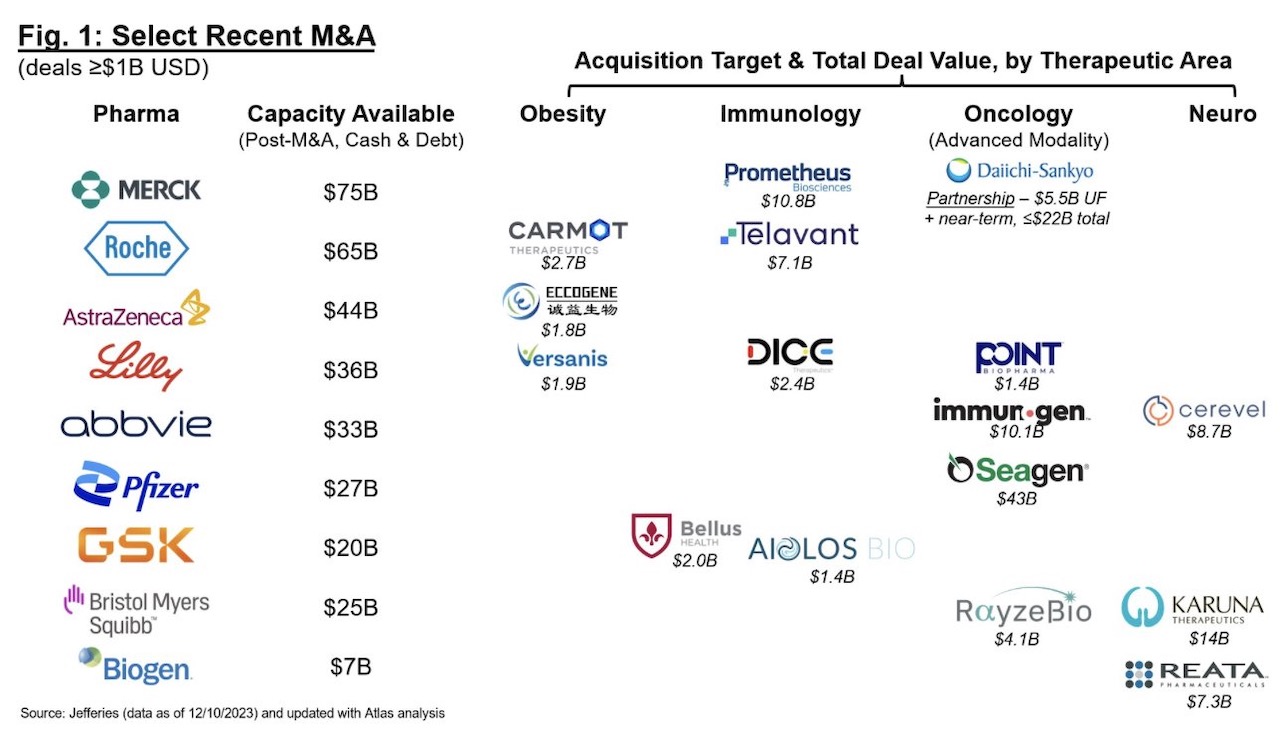Brad Loncar, Founder of BiotechTV, observed during an interview in October 2023 that some people were dressed as GLP-1 agonists for Halloween. He was interviewing Dr. Eric Topol, of Scripps Research Institute, who suggested they dress up as skeletons due to how little is known about the mode of action in this class of drugs and due to the loss of muscle mass, estimated to be about 30% of total weight loss during treatment.
While GLP-1 agonists have been available to diabetics for over 20 years, what has captured investors’ imagination in recent months is the drugs’ dramatic potency as a weight loss therapy grafted onto an enormous total addressable market (TAM). The potency is derived, so far, from approved drugs with higher doses of GLP-1 agonist compared to the dose used to treat diabetes. Novo Nordisk received approval for liraglutide (Saxenda) for weight loss in the European Union in 2015. And then in 2021, Novo Nordisk gained FDA approval for semaglutide (Wegovy) for chronic weight management in adults with obesity or overweight with at least one weight-related condition.
The pace of approval is quickening as the FDA appears not to deny a single drug developers’ appetite to dose more and approve more with the side effects merely footnoted. Eli Lilly and Company’s tirzepatide (Mounjaro) was FDA-approved in 2022 for type 2 diabetes but not explicitly for weight loss. And on November 8, 2023, the FDA approved tirzepatide (Zepbound) for weight loss. It is the first obesity treatment of its kind (dual agonist) that activates both glucose-dependent insulinotropic polypeptide (GIP) and GLP-1 (glucagon-like peptide-1) hormone receptors. The label for Zepbound includes a Boxed Warning regarding thyroid C-cell tumors. Plus, the FDA says, “[Zepbound] has not been studied in patients with a history of pancreatitis, or with severe gastrointestinal disease, including severe gastroparesis.” There is neither debate about how or when to end GLP-1 treatment nor clinical data beyond a year or so.
It appears children are the next targeted category. In December 2022, the FDA approved semaglutide as an adjunctive agent to lifestyle modifications for chronic weight management in pediatric patients 12 years or older with an initial BMI equal to or greater than the 95th percentile standardized for age and sex.
RELATED: From 2013: “global branded junk food companies have found a new metabolic donkey in the populations of the third world.”
Given the potential for this class of drugs to address the broad societal burden of obesity, it is no wonder that financial markets and celebrity weight loss influencers have created a bandwagon phenomenon that appears to be gaining momentum. And the fever created by a focus on short term results – for example, by paying $10,000 to $15,000 to lose about 15% of body weight in 12 months, obscures the much worse condition of sarcopenic obesity that results upon cessation of therapy, when most people regain all the weight in fat, not muscle mass.

Side effects include gastroparesis, a serious condition characterized by delayed stomach emptying. In some cases, gastroparesis may be transient, resolving on its own or with treatment. In other instances, it can be a long-term or lifelong condition. Other side-effects include rapid or irregular heartbeat, nausea, vomiting and pancreatitis, an inflammation of the pancreas, which presents as severe abdominal pain. Plus, there is some evidence that people develop resistance.
GLP-1 is a naturally-occurring neurotransmitter produced in the small intestines. The signaling pathway to the brain involves the vagus nerve, which is a key component of the gut-brain axis. This new class of synthetic GLP-1 agonists act directly in various parts of the body, including the brain and pancreas, elevating the potency of this naturally-occurring neurotransmitter to something closer to a hormone. No wonder the side-effects resemble symptoms of toxicity.

A Pharmacokinetic Arms Race
There is heated competition in the obesity treatment market among major pharmaceutical companies. German drugmaker Boehringer Ingelheim, in collaboration with Danish biotech Zealand Pharma, is developing a unique obesity treatment targeting GLP-1 and glucagon hormones. This dual agonist approach is expected to suppress appetite while increasing calorie burning. Other companies like Merck and Altimmune are also pursuing similar treatments. Bayer is considering partnerships for entering this market, while Pfizer focuses on its existing pipeline and potential acquisitions.
The market potential for obesity treatments is rapidly growing, with estimates reaching $150 billion annually. This expansion is partly due to the high demand and limited supply of existing weight-loss drugs from companies like Novo Nordisk and Eli Lilly, the current leaders in the dose escalation race.
Shares of Eli Lilly rose 59% in 2023, based mostly on its weight loss drugs and pipeline, making it the most valuable healthcare company in the world, with a valuation of around $550 billion.
Dual agonists offer the promise of fewer side-effects and a chance for new entrants to gain a foothold through the acquisition of early-stage biotechs. According to Altimune’s CEO, Vipin Garg, the company is developing a dual agonist, a GLP-1 agonist plus a glucagon agonist. In an interview this month, Garg says, “It’s really not clear how exactly it [GLP-1 agonists] works…we are really in the early stages of obesity drug development.” A recent read-out from Altimmune’s Phase 2 trial showed a 15.6% weight loss at 48 weeks, and the company expects weight loss to continue with time.

Two dual agonsists are in focus now: GIP receptor agonist and glucagon receptor agonists. The dual action on both GLP-1 and GIP receptors has shown promising results in cardiometabolic profiles, excluding any consideration for side-effects and costs, which are typically not covered by insurance for purposes of weight loss. As such, GLP-1s seem out of reach as population-level solution for excessive caloric intake.
Winners & Losers
The GLP-1 bandwagon has created a variety of winners and losers in financial markets including companies in the medtech sector, weight loss companies and other biotechs caught in the blast zone of impact.
And the bandwagon is changing business models among some pharmaceutical companies. Eli Lilly recently launched a new margin- and funnel- and moat-building online service, LillyDirect, offering telehealth prescriptions and direct home delivery of its new Zepbound weight-loss drug. Perhaps this is the first step towards an even higher trapeze of a recurring revenue for weight-loss-as-a-service business model?
Upon the announcement of LillyDirect, shares in WW International, better known as WeightWatchers, tumbled 11%. The decline followed a previous 11% slump after Barclays Plc gave WW its only sell-equivalent rating, saying the company was still in the early stages of its transition to a more digital-focused model. Shares in other companies that provide online access to prescription weight-loss drugs also slid. LifeMD Inc. slumped 32%, the most since March 2020, while Hims & Hers Health Inc. dropped 6.4%.
In some cases, enterprise values (EV) have tripled in a short period of time, as in the case of Altimmune’s stock during Q4-23. For other companies, such as ProKidney, the last few months of the year produced a precipitous decline – into negative EV territory – as the market assumes end-stage renal failure (ESRF) will all but disappear as a result of this new class of GLP-1 agonist drugs. ProKidney now trades with a negative EV, meaning the company is worth less than the value of cash on its balance sheet (about $350 million), making its years of positive clinical trials (currently in Phase 3) and patent portfolio worthless through the arithmetic of public company valuation.
This is the bandwagon effect: distorted values that blindly reinforce trends (group think), assumptions of best/worst case outcomes by applying short-term inputs, sharply rising/falling asset prices and the most essential ingredient, fear of missing out (FOMO).
NeuroBo Pharmaceuticals may be a good candidate for a FOMO play in the dual agonist arena. Its most advanced drug candidate, A-1726, is a novel oxyntomodulin analogue functioning as a GLP1R/GCGR dual agonist for the treatment of obesity. The IND approval is expected soon with Phase 1 trials commencing shortly thereafter. Its other therapy is DA-124, a novel G-Protein-Coupled Receptor 119 (GPR119) agonist with development optionality as a standalone and/or combination therapy for both MASH and T2DM. Its Phase 2a first patient was dosed September 15, 2023 with interim data due in 1H 2024. Full results due in 2H 2024. The company is backed by strategic partner and major shareholder, Dong-A ST. DA-1726 outperformed Semaglutide (WEGOVY), a GLP-1 agonist, in mouse models of obesity. The company has a negative EV.
In summary, the GLP-1 agonist bandwagon is creating opportunities to exploit the potential mispricing of companies that could produce unusual gains in the short term and also when the inevitable fever breaks as the media always finds the bad outcomes to hype.
As with all early-stage investing, risk of loss is high and suitable only for speculative investors.

Cover image by DALL-E
—————————–
The ideas presented on this site do not constitute a recommendation to buy or sell any security. Investors are advised to conduct their own independent research into individual stocks before making a purchase decision. In addition, investors are advised that past stock performance is not indicative of future price action. You should be aware of the risks involved in stock investing, and you use the material contained herein at your own risk. Neither SYNTHETIC.COM nor any of its contributors are responsible for any errors or omissions which may have occurred. The analysis, ratings, and/or recommendations made on this site do not provide, imply, or otherwise constitute a guarantee of performance. SYNTHETIC.COM posts may contain financial reports and economic analysis that embody a unique view of trends and opportunities. Accuracy and completeness cannot be guaranteed. Investors should be aware of the risks involved in stock investments and the possibility of financial loss. It should not be assumed that future results will be profitable or will equal past performance, real, indicated or implied. The material on this website is provided for information purpose only. SYNTHETIC.COM does not accept liability for your use of the website. The website is provided on an “as is” and “as available” basis, without any representations, recommendations, warranties or conditions of any kind.

